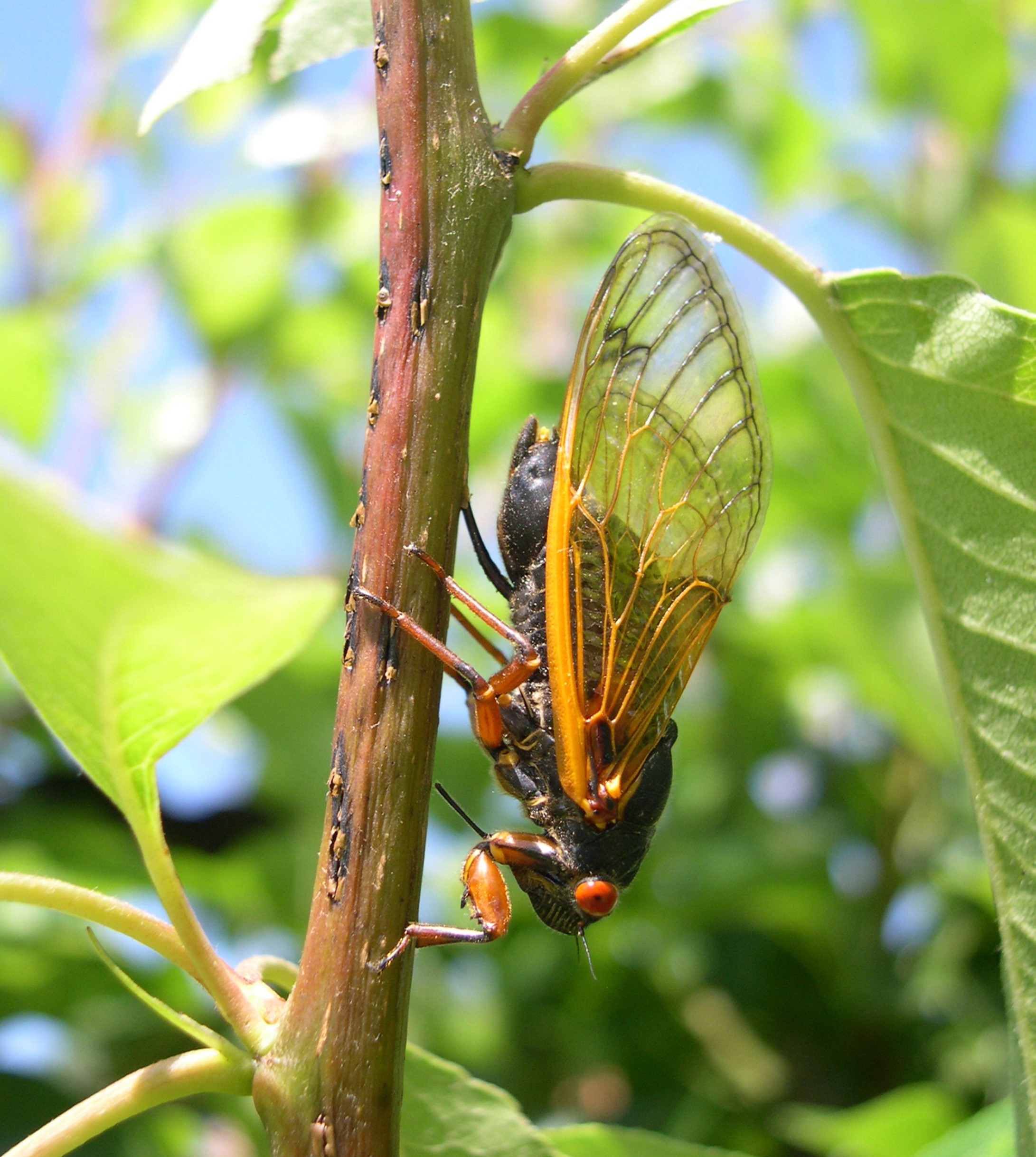
Credit: Fontaine, K., Cooley, J., and Simon, C., 2007, CC BY 2.5, via Wikimedia Commons
It’s going to be a very noisy summer! This year, more cicadas will fill the air with—song?—than any summer since 1803.
Cicadas evolved 150 million years ago, and 3,000 species now live on nearly every continent. These are called “annual” cicadas.
They live a few years underground, then crawl up a tree and shed their crusty “underground” skin for a final molt into their winged adult form.
They live for a few weeks, and the males screech all day long—which the females find attractive. They mate, the females inject their eggs beneath the bark of a tree, and they both die.
The nymphs hatch and fall to the ground, where they burrow into the soil to grow and repeat the process.
If you live in the South or Southwest, you see—and hear—the green or brown annual cicada.
But in the middle of the US—and only here—a special cicada has evolved, with black bodies and red eyes. Two types exist: one lives underground for 13 years, and the other for 17.
No one knows exactly how they time it, but billions emerge at once. Then, every 221 years, as in 2024, the 13- and 17-year cycles align … and they all come out together.
The last time this happened, Thomas Jefferson was negotiating the Louisiana Purchase. If he knew what a racket he was in for, he might have rethought the deal.
Background
Synopsis: Each year, cicadas herald the start of summer in the eastern half of the United States with their crescendos of buzzing choruses. Spending most of their lives underground as wingless nymphs, cicadas emerge for their final metamorphosis into winged adults as the soil around them warms. While some spend just a few years underground, others wait on cycles of 13 or 17 years before emerging by the millions as a “brood.” In 2024, two broods will emerge together for the first time since 1803, when President Thomas Jefferson secured the Louisiana Purchase.
- Cicadas are insects that live on every continent except Australia.
- They are “true bugs” (the order Hemiptera), meaning their mouthparts are like sharpened straws that pierce plant parts to suck liquids out.
- While most fossil cicadas are known from the Cenozoic Era, cicadas first emerged in the Late Triassic Epoch, about 150 million years ago.
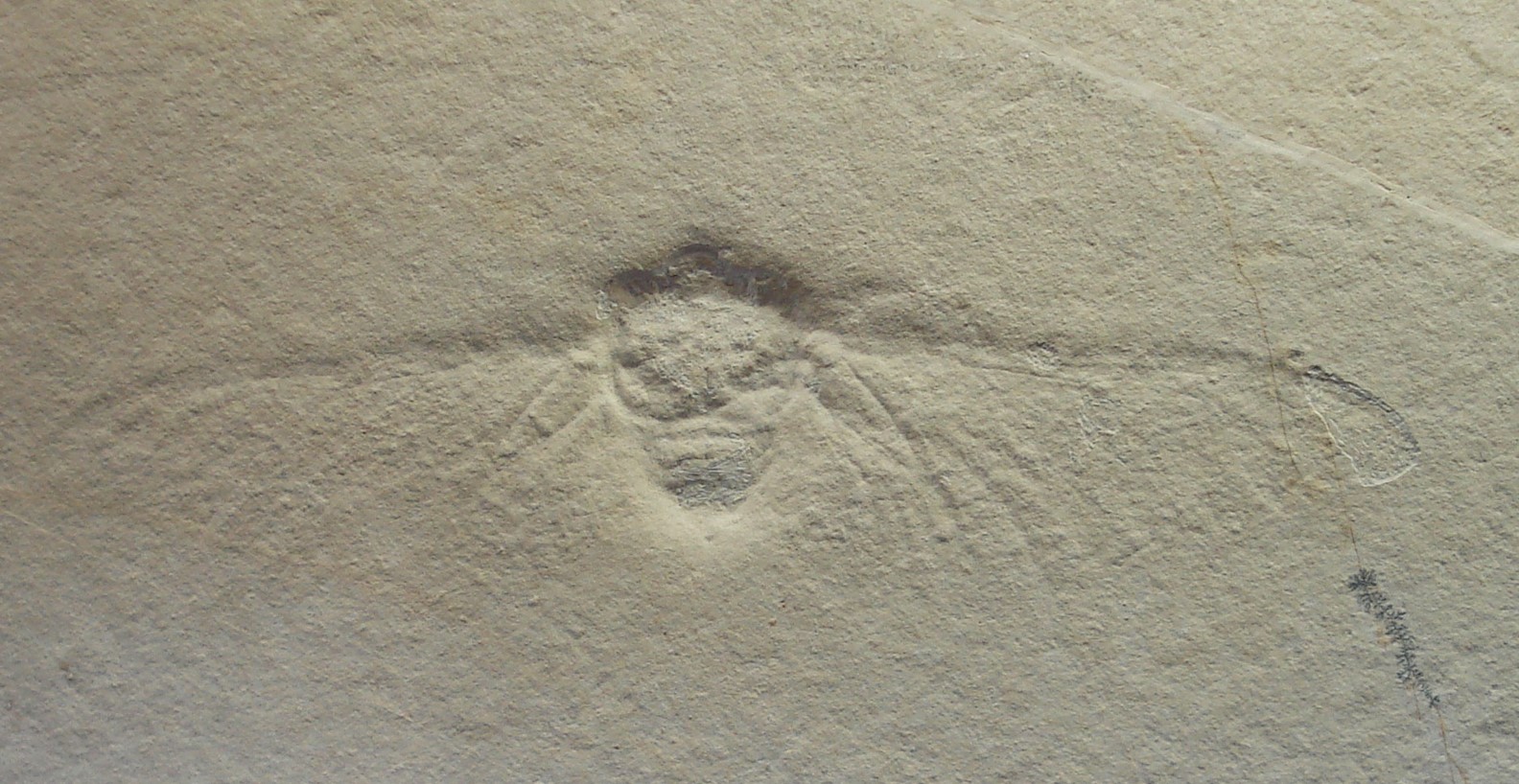
Cicada fossil (Prolystra lithographica) from the Tithonian Stage of the Upper Jurassic Series, formed about 150 to 145 million years ago.
Credit: Ghedoghedo, CC BY-SA 3.0, via Wikimedia Commons - More than 3,000 species of (so-called annual) cicada exist globally today, but seven Magicicada species in North America have evolved unusual extended life cycles: four species live for 13 years (13-year periodical cicadas) while three species live for 17 years (17-year periodical cicadas).
- Annual cicada nymphs emerge in late June through August after a growth period of 2 to 5 years underground.
- Periodical cicadas that emerge together in the same 13- or 17-year cycle are known as broods and are distinguished by roman numerals (e.g., Brood XIX). Broods are also constrained geographically. Today there are 3 active 13-year broods and 12 active 17-year broods. As many as 1.5 million cicadas can emerge on a single acre.
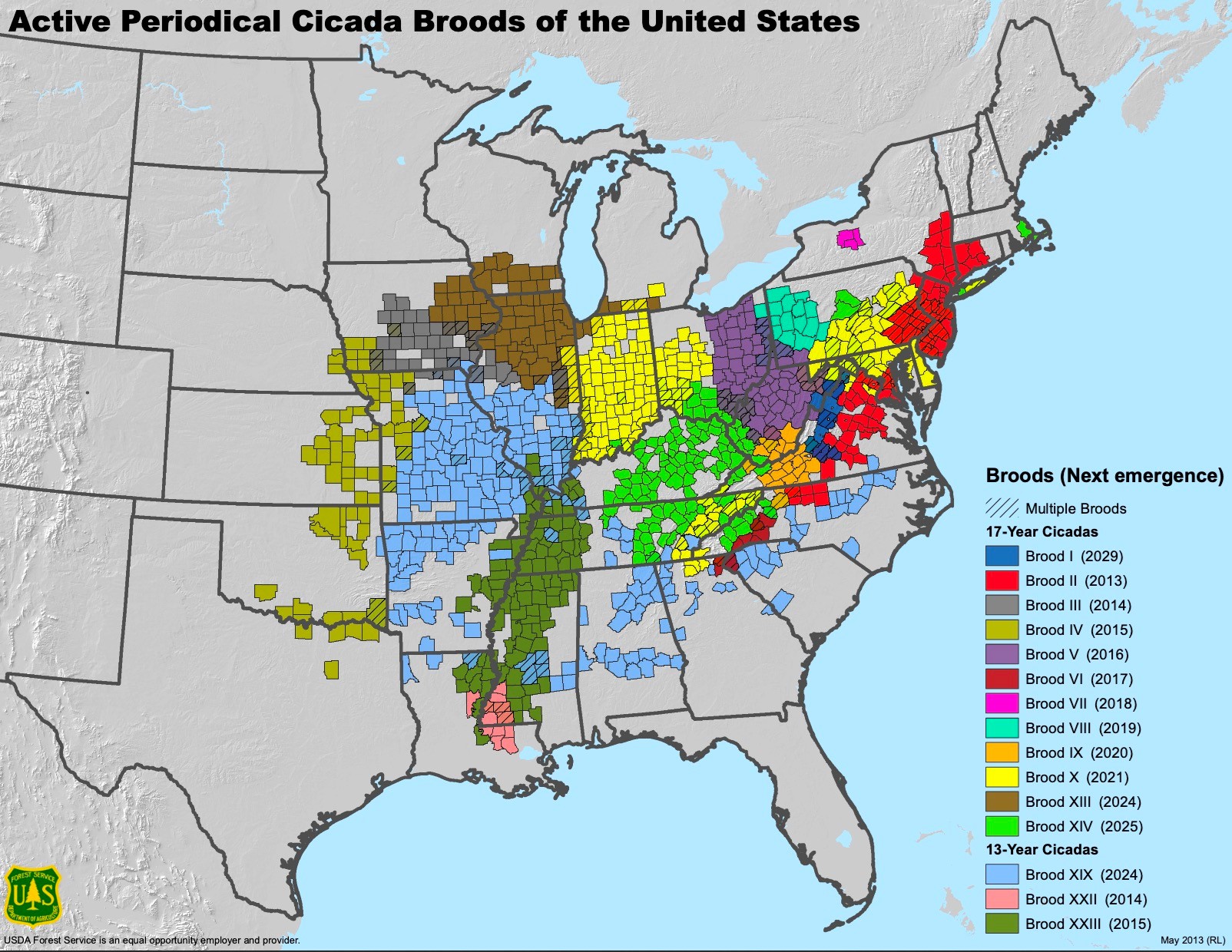
Map of active periodical cicada broods of the United States.
Credit: USDA Forest Service- Periodical cicada nymphs tend to emerge from late April through early June when soil temperatures reach 64°F (18°C) at a depth of around 12 in (31 cm).
- When they emerge, cicadas are 1 to 2 in (2.5–5 cm) long and have large bulging eyes: black or green for the annual types and bright red for the periodical bugs.
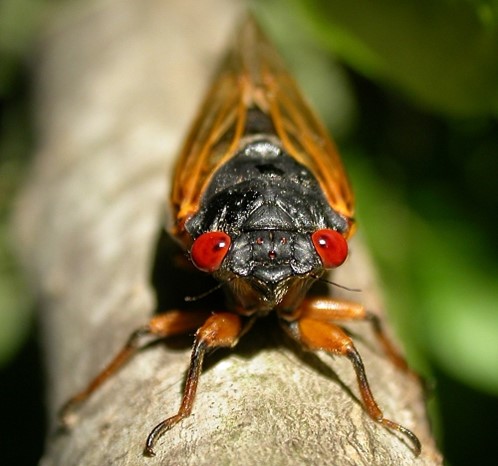
Image of an adult Magicicada septendecim, a 17-year periodical cicada, taken in Danville, Illinois, USA.
Credit: Martin Hauser, CC BY-SA 2.5, via Wikimedia Commons- While adult annual cicadas can be patterned and are brown, green or black with green veins in their transparent wings, periodical cicadas are a deep, solid black with orange veins in their transparent wings.
- Cicadas don’t have chewing mouthparts or stingers, so they can’t hurt you, and they don’t eat leaves, they just suck liquid from the xylem of plants.
- Cicadas are not locusts. Locusts are grasshoppers from a different order of insects and are harmful because they devour plants (ED-167 Swarming Locusts).
- Cicadas are beneficial, aerating soils and providing food for their predators, but they are most noticeable to us because of their loud mating calls.
- For some Americans, the sound of male cicadas is the sound of summertime, but their songs of romance can be deafening. Once they mate, the songs stop.
- Males have ribs of alternating stiff and flexible membranes in their first abdominal segment called tymbals that they can bend to create a clicking sound which is amplified in their abdomen to produce their mating song, which can carry up to a mile away. Listen to these cicada calls:
- A single annual Neotibicen superbus cicada calling in Irving, Texas, in June 2012
- Calling song of a periodical 17-year Magicicada cassini
- Broods can produce 100-decibel crescendos, as loud as a chain saw about 3 ft (1 m) away. Listen to “Just how loud can cicadas get?” (via YouTube).
- Females flit their wings to attract males, but do not otherwise make noise.
- Once they have mated, the males die.
- Females use their ovipositor, a sharp egg-laying organ, to cut tiny egg nests into twigs where they lay their eggs in clusters of about 20. After laying their eggs, the females die, too.
- Males have ribs of alternating stiff and flexible membranes in their first abdominal segment called tymbals that they can bend to create a clicking sound which is amplified in their abdomen to produce their mating song, which can carry up to a mile away. Listen to these cicada calls:
- Regardless of their life span, both annual and periodical cicadas have similar life cycles, spending most of their lives underground.
- Within 6 to 10 weeks of being deposited, the eggs hatch. The newly emerged nymphs (juvenile cicadas) fall to the ground and burrow into the soil, searching for plant roots from which they suck nutrients. At this point they look like white ants or termites./p>
- The nymphs molt by shedding their exoskeleton as many as five times during the years they spend underground growing larger and stronger.
- As soil temperatures rise in the spring, the nymphs start digging up to the surface, leaving half-inch (1.3 cm) holes behind.
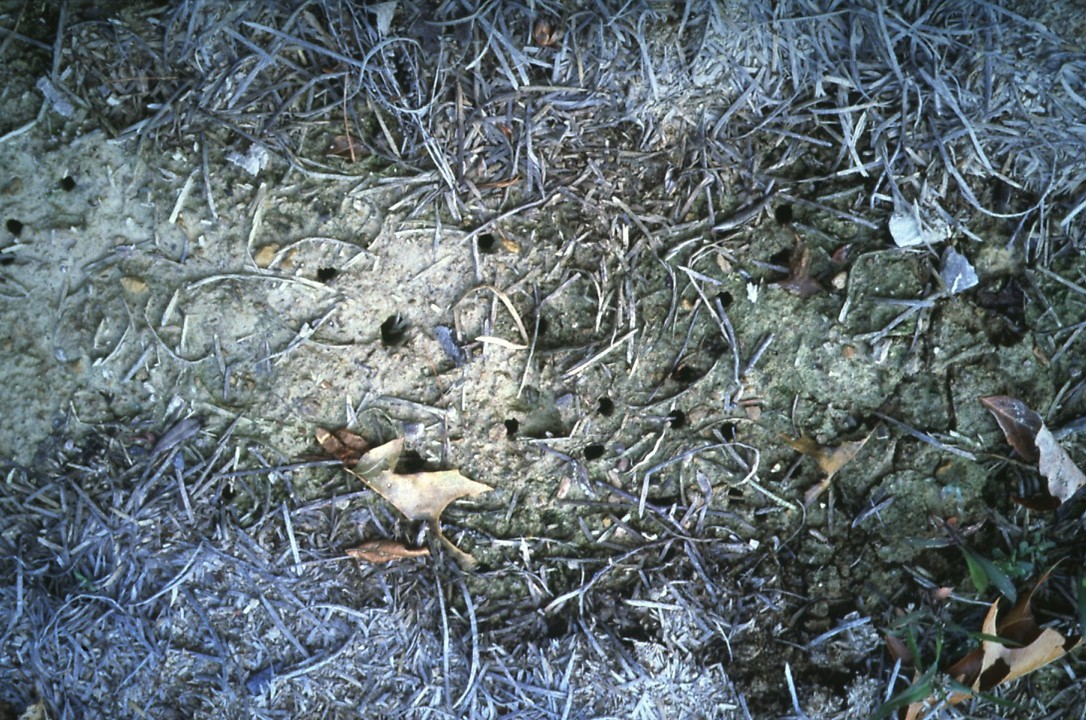
Magicicada emergence holes left by nymphs.
Credit USDA, public domain, via Wikimedia Commons - The light-brown, wingless nymphs then climb into the trees to find a branch for their final molting and transformation into winged adults.
- As they leave their final nymph exoskeleton, they are white, but they darken over about five days as their bodies harden and their wings become rigid enough to support them in flight.
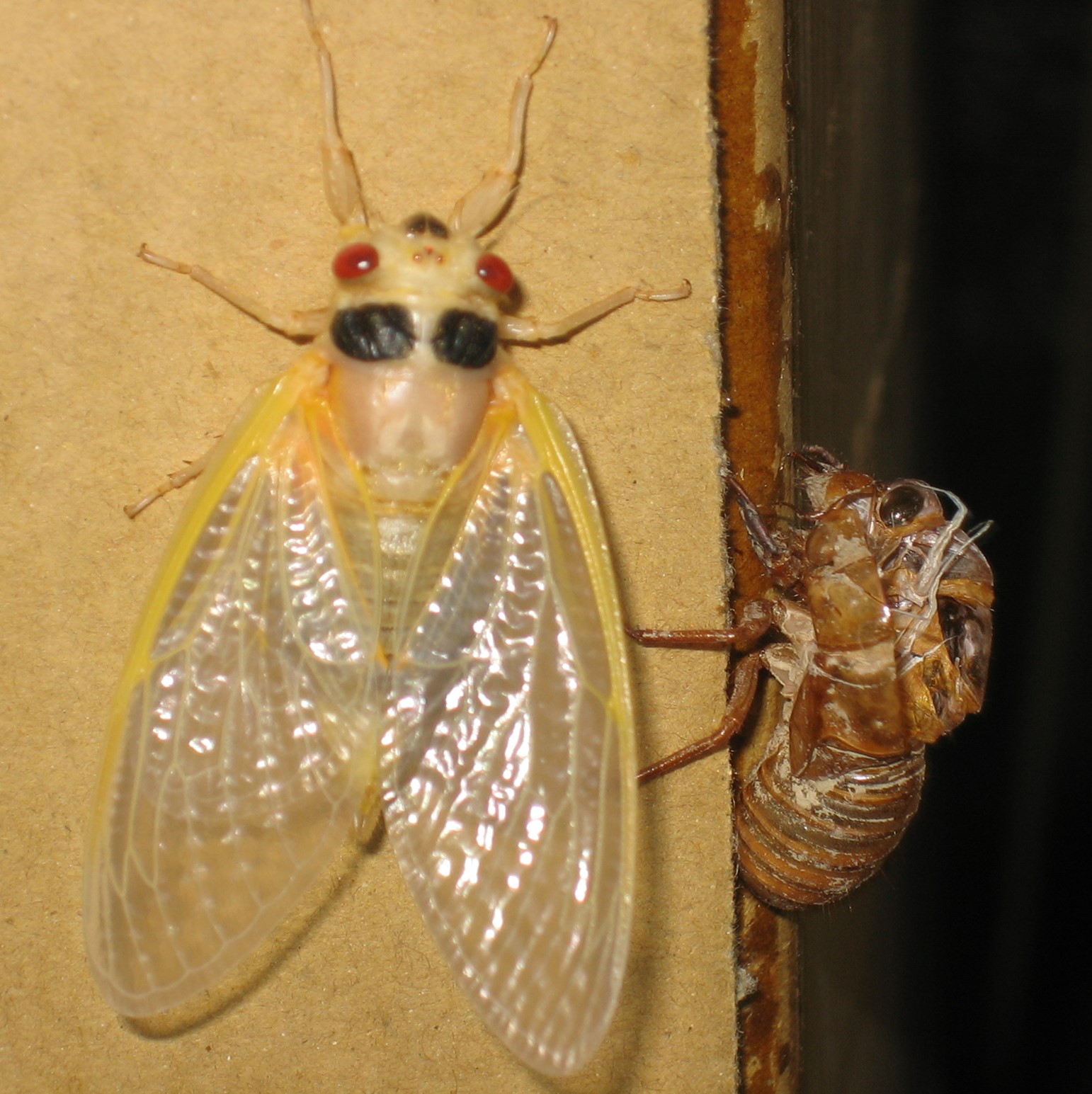
A Magicicada that just molted and is waiting to dry and darken in color. The empty brown skin casing nearby is the final nymph exoskeleton that the cicada just came out of.
Credit: Jeff R. (WikiJeff001 at English Wikipedia), public domain, via Wikimedia Commons - Adult cicadas live for about two to six weeks in trees near where they emerged, sipping nutrients through the twigs, mating, and beginning the cycle again.
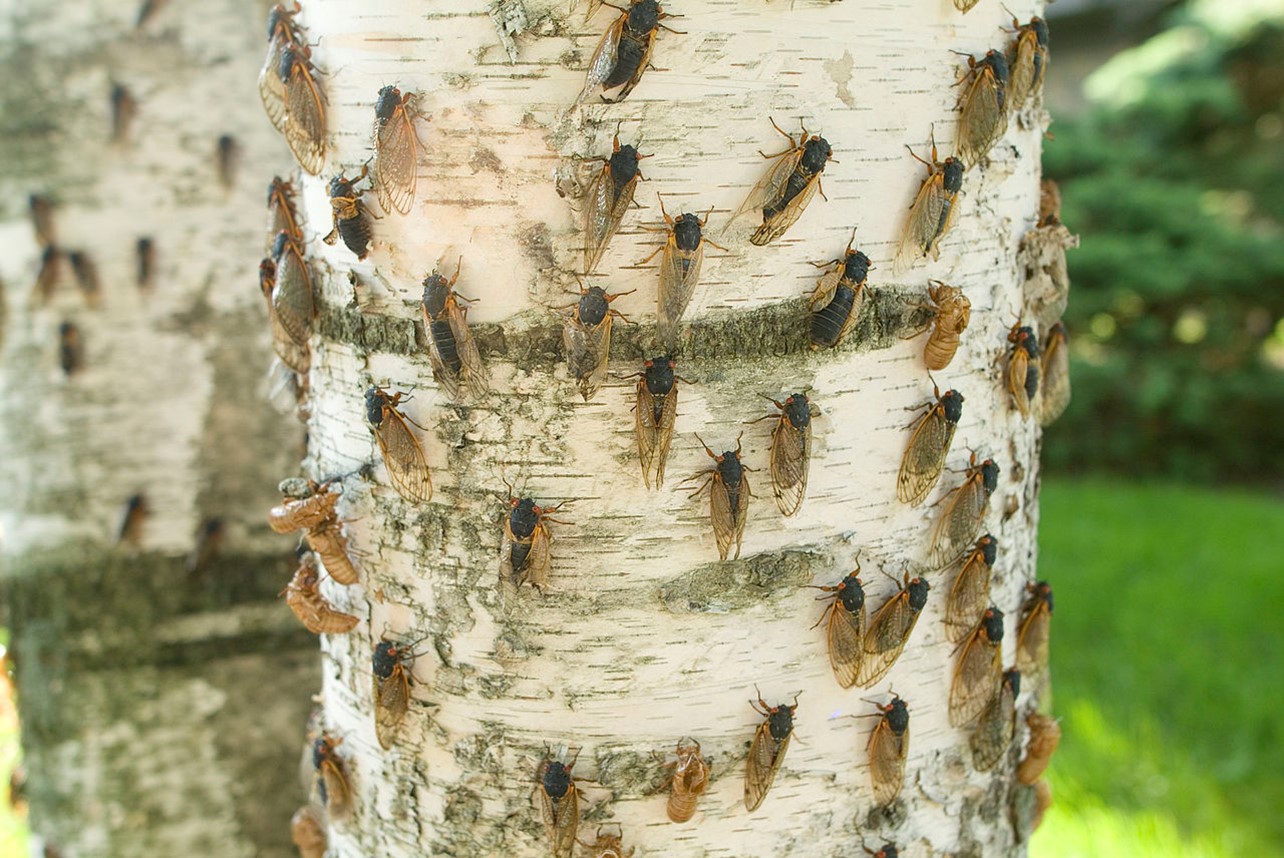
Cicadas that have emerged from their nymph stage in Illinois.
Credit: I, Marg0marg, CC BY-SA 3.0, via Wikimedia Commons
- It is the length of the underground cycle that makes periodical cicadas some of Earth’s longest-lived insects, and it is the regularity, synchronization and intensity of the brood cycles that makes them one of entomology’s greatest mysteries.
- Spending an average of just 4 weeks aboveground out of a 676- to 884-week lifetime means periodical cicadas are underground for 99.5% of their life, effectively avoiding predators like birds, reptiles and mammals.
- They are thought to mark the passage of years and the coming of spring by sensing annual cycles of nutrients flowing through plant roots.
- Periodical nymphs somehow track the number of years they spend underground, then emerge together by the millions once the soil is around 64°F (18°C).
- Emerging all at the same time makes it easier for periodical cicadas to find mates, and the mass appearance bombards predators with too much prey—once predators have eaten their fill, the abundant remaining cicadas can still reproduce. This synchronization benefits the brood as a whole.
- But how and why do they consistently emerge every 13 or 17 years?
- One hypothesis proposes that the unique numbers of 13 and 17 are prime numbers, creating less likelihood that the broods will emerge during their predators’ population booms, which normally occur at 2- or 10-year intervals.
- But then why don’t all 3,000 species of cicadas globally use the same strategy as their American cousins? Some researchers think that periodical cicadas hit an objective like a critical weight or developmental milestone that coordinates with their biological clock to give them a “green light” to emerge.
- Some broods are emerging 4 years earlier than usual. It appears that a brood’s life cycle length is more flexible than expected, as if there is a 4-year biological clock that assesses readiness so that broods are emerging at 9, 13, 17 or 21 years of age.
- Entomologists wonder how periodical cicadas will respond as soil temperatures rise in a warming world.
- In 2024, it will be a cicada fiesta in the eastern United States with the coemergence of Broods XIII and XIX (13 and 19, respectively, in roman numerals), an event which only happens every 221 years (13 × 17 = 221).
- The last time these two broods emerged together was 1803, the year of the Louisiana Purchase, when Thomas Jefferson was in his first term as America’s third president. The next time these two reappear together will be in 2245.

Thomas Jefferson, the principal author of the Declaration of Independence and third president of the United States of America (from 1801 to 1809), would have been president during the last dual emergence of Broods XIII and XIX. Several states that were part of the Louisiana Purchase that year would have seen this coemergence.
Credit: Rembrandt Peale, 1880, public domain, via Wikimedia Commons - Brood XIII (brown on map) has a 17-year life cycle. Three species (Magicicada septendecim, Magicicada cassini, and Magicicada septendecula) will emerge in five states (IA, IL, IN, MI and WI).
- The Great Southern Brood, Brood XIX (light blue on map), has a 13-year life cycle and includes four species (Magicicada tredecim, Magicicada neotredecim, Magicicada tredecassini and Magicicada tredecula) that will emerge in 17 states (AL, AR, GA, IA, IL, IN, KS, KY, LA, MD, MO, MS, NC, OK, SC, TN and VA).
- Both broods are scheduled to emerge in Iowa, Illinois and Indiana in 2024.
- The last time these two broods emerged together was 1803, the year of the Louisiana Purchase, when Thomas Jefferson was in his first term as America’s third president. The next time these two reappear together will be in 2245.
- While cicadas hide underground from predators for most of their lives, they are still vulnerable to predators throughout their life cycle.
- Ants may consume newly hatched nymphs on the ground.
- Larger nymphs may be consumed by burrowing animals like moles as well as birds, bats, wasps, spiders and mantises.
- When they emerge en masse, many animals, including mammals, birds, fish, amphibians and reptiles, join in the feast.
- Fungal diseases can also kill cicadas, both in their nymph and adult forms.
- One fungus, Massospora cicadina, leaves spores that stay dormant in the soil to specifically attack periodical cicada adults. This fungus doses the cicadas with psilocybin (a molecule that causes insect nervous systems to go haywire) and cathinone (an amphetamine, which makes insect nervous systems hyperactive), causing them to mate frenetically, infecting both females and males to spread spores as they fly.
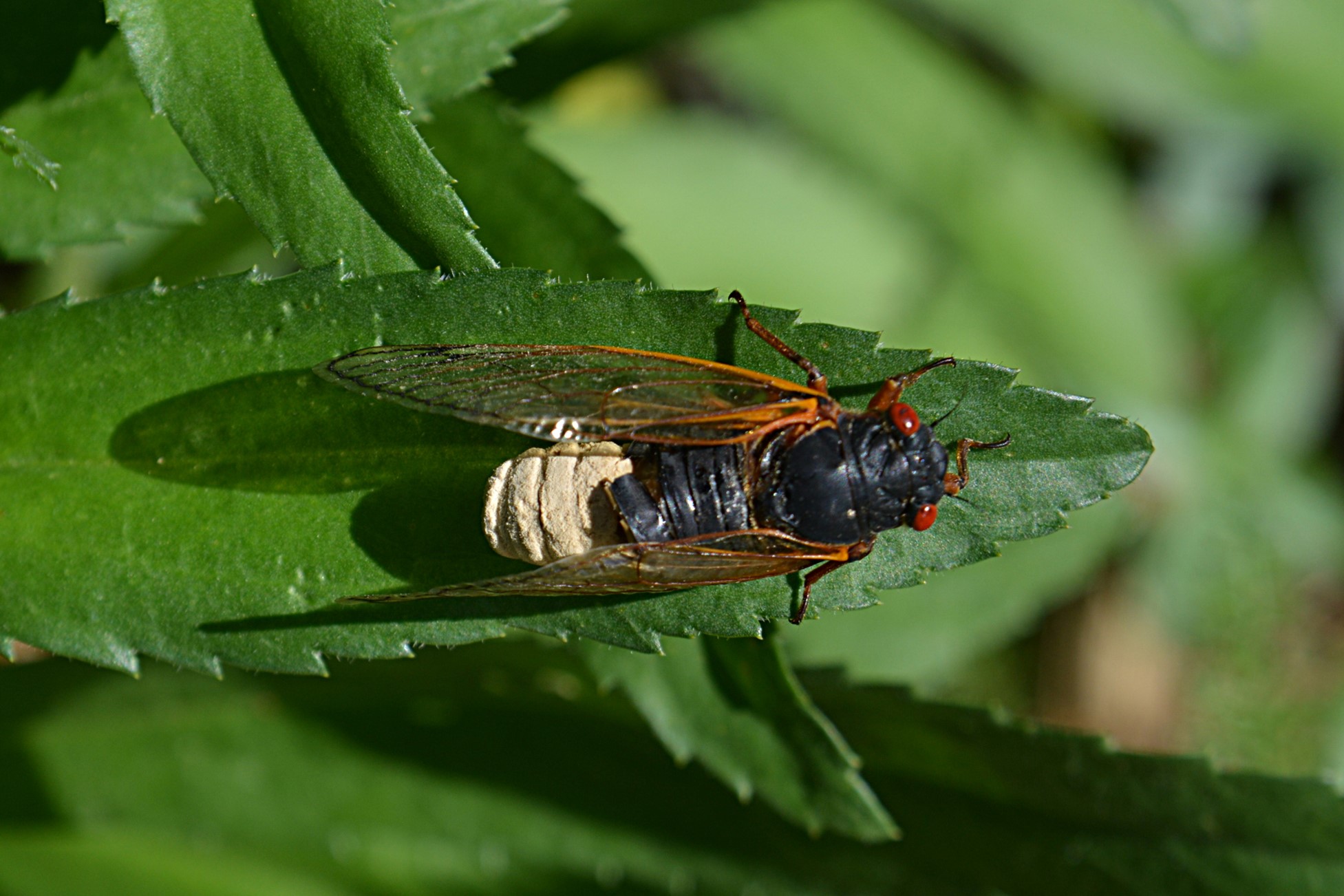
A live periodical cicada sitting on a leaf. The rear half of the exoskeleton has peeled away, exposing an extensive fungal infection. The ridges on the cicada's abdomen are still visible within the fungus.
Credit: G. Edward Johnson, CC BY 4.0, via Wikimedia Commons

